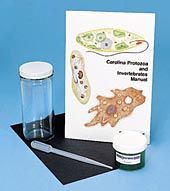My Cart
Your Shopping Cart is currently empty. Use Quick Order or Search to quickly add items to your order!

Cells or unicellular organisms that move in response to light exhibit phototaxis. Phototaxis is easily demonstrated using Euglena, Chlamydomonas, or Volvox. The following 2 demonstrations can be done in your classroom with inexpensive materials you probably already have on hand. If you’re pressed for time, check out our Euglena Phototaxis Kit (shown right). It’s got all the materials you need to demonstrate algal phototaxis—plus the Carolina™ Protozoa and Invertebrates Manual.
Because light is essential for photosynthesis, many algae have developed phototactic responses. An algal cell can have either a positive phototactic response (it moves toward light) or a negative phototactic response (it moves away from light). Many algae respond negatively under bright light and positively under dim light. Interestingly, Euglena displays a positive phototactic response in daylight, but at night, even when light is introduced, it is unresponsive.
Materials
Procedure
Optional:
To establish at what light intensity algae react negatively and to what wavelength they respond, perform the demonstration using several different light intensities and wavelengths (colors).
Materials
Procedure
Further your students’ knowledge of Euglena and other protozoans with the following kits, cultures, and equipment.
Carolina™ Protozoa Slide Sets (Euglena)